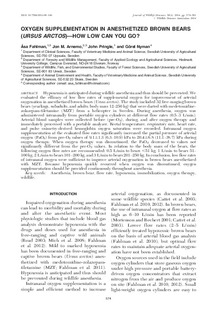| dc.contributor.author | Fahlman, Åsa | |
| dc.contributor.author | Arnemo, Jon Martin | |
| dc.contributor.author | Pringle, John | |
| dc.contributor.author | Nyman, Görel | |
| dc.date.accessioned | 2015-02-27T13:10:54Z | |
| dc.date.available | 2015-02-27T13:10:54Z | |
| dc.date.issued | 2014 | |
| dc.identifier.citation | Åsa Fahlman, Jon M. Arnemo, John Pringle, and Görel Nyman (2014) OXYGEN SUPPLEMENTATION IN ANESTHETIZED BROWN BEARS (URSUS ARCTOS)—HOW LOW CAN YOU GO?. Journal of Wildlife Diseases: July 2014, Vol. 50, No. 3, pp. 574-581. | nb_NO |
| dc.identifier.uri | http://hdl.handle.net/11250/278057 | |
| dc.description.abstract | Hypoxemia is anticipated during wildlife anesthesia and thus should be prevented. We evaluated the efficacy of low flow rates of supplemental oxygen for improvement of arterial oxygenation in anesthetized brown bears (Ursus arctos). The study included 32 free-ranging brown bears (yearlings, subadults, and adults; body mass 12–250 kg) that were darted with medetomidine-zolazepam-tiletamine (MZT) from a helicopter in Sweden. During anesthesia, oxygen was administered intranasally from portable oxygen cylinders at different flow rates (0.5–3 L/min). Arterial blood samples were collected before (pre-O2), during, and after oxygen therapy and immediately processed with a portable analyzer. Rectal temperature, respiratory rate, heart rate, and pulse oximetry-derived hemoglobin oxygen saturation were recorded. Intranasal oxygen supplementation at the evaluated flow rates significantly increased the partial pressure of arterial oxygen (PaO2) from pre-O2 values of 9.1±1.3 (6.3–10.9) kPa to 20.4±6.8 (11.1–38.7) kPa during oxygen therapy. When oxygen therapy was discontinued, the PaO2 decreased to values not significantly different from the pre-O2 values. In relation to the body mass of the bears, the following oxygen flow rates are recommended: 0.5 L/min to bears <51 kg, 1 L/min to bears 51–100 kg, 2 L/min to bears 101–200 kg, and 3 L/min to bears 201–250 kg. In conclusion, low flow rates of intranasal oxygen were sufficient to improve arterial oxygenation in brown bears anesthetized with MZT. Because hypoxemia quickly recurred when oxygen was discontinued, oxygen supplementation should be provided continuously throughout anesthesia. | nb_NO |
| dc.language.iso | eng | nb_NO |
| dc.publisher | Wildlife disease organization | nb_NO |
| dc.relation.uri | http://www.jwildlifedis.org/doi/abs/10.7589/2013-06-148?url_ver=Z39.88-2003&rfr_id=ori:rid:crossref.org&rfr_dat=cr_pub%3dpubmed | |
| dc.subject | anesthesia | nb_NO |
| dc.subject | brown bear | nb_NO |
| dc.subject | flow rate | nb_NO |
| dc.subject | hypoxemia | nb_NO |
| dc.subject | immobilization | nb_NO |
| dc.subject | oxygen therapy | nb_NO |
| dc.subject | wildlife | nb_NO |
| dc.title | Oxygen supplementation in anesthetized brown bears (Ursus Arctos) : how low can you go? | nb_NO |
| dc.type | Journal article | nb_NO |
| dc.type | Peer reviewed | nb_NO |
| dc.source.pagenumber | 574-581 | nb_NO |
| dc.source.volume | 50 | nb_NO |
| dc.source.journal | Journal of Wildlife Diseases | nb_NO |
| dc.source.issue | 3 | nb_NO |
| dc.identifier.doi | 10.7589/2013-06-148 | |
